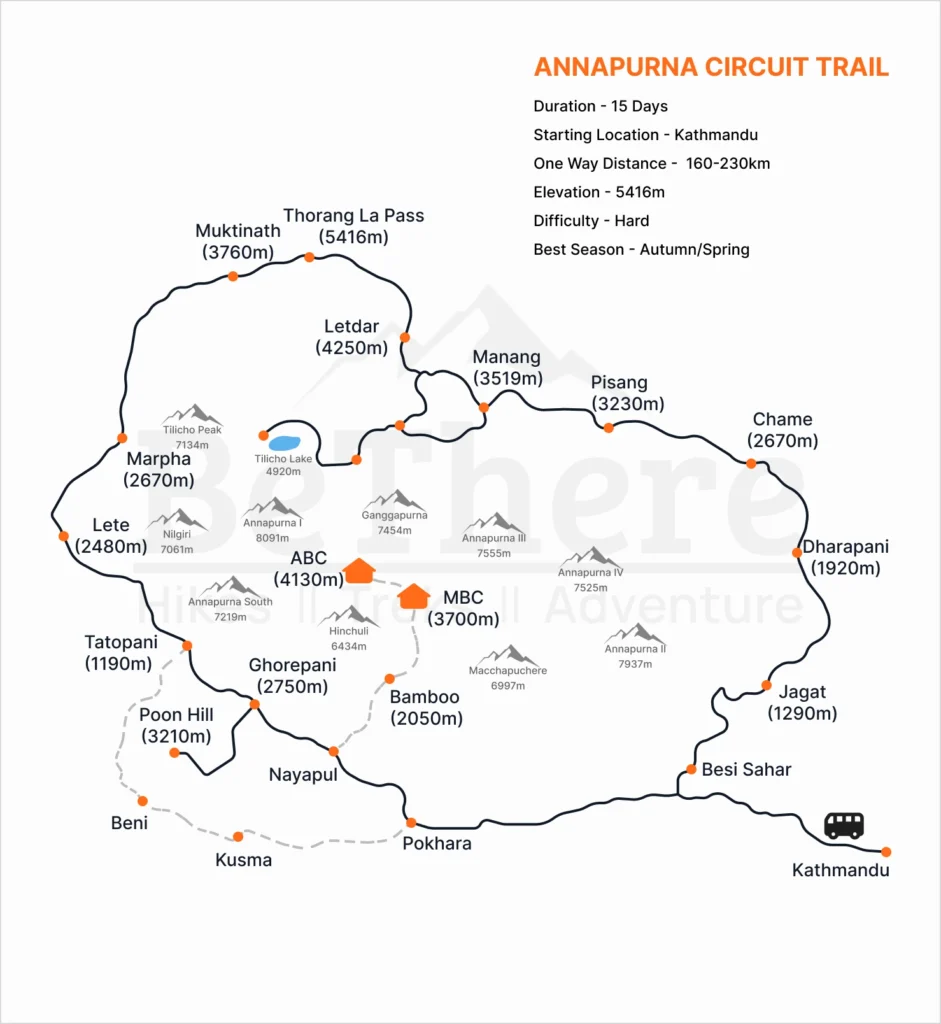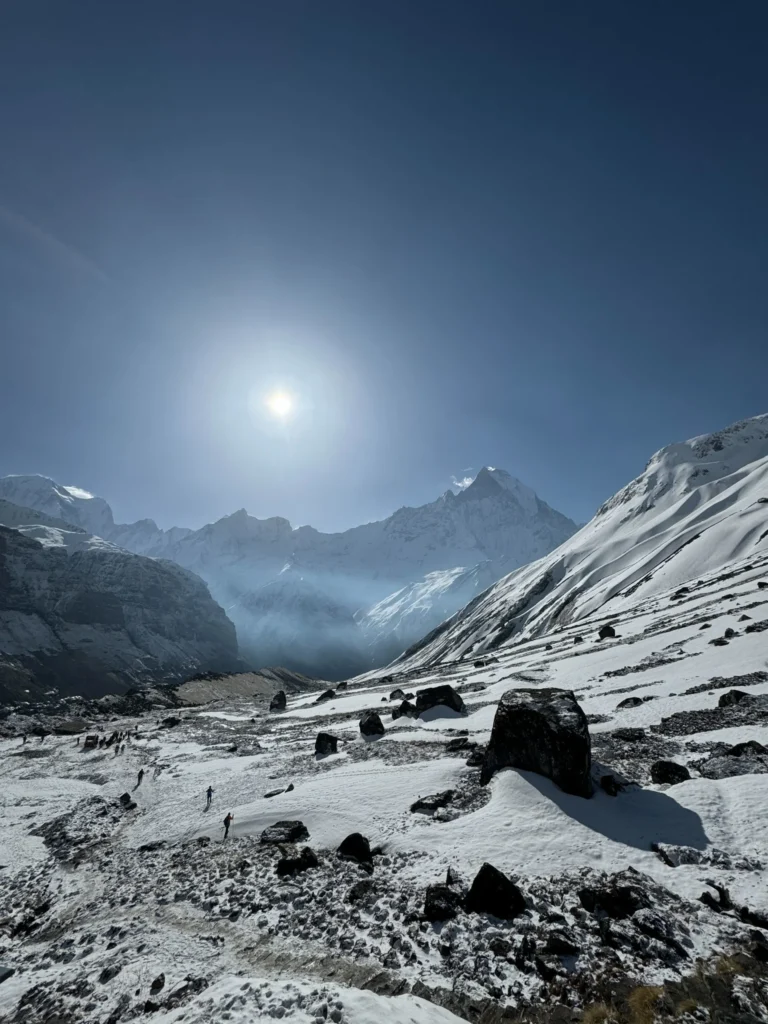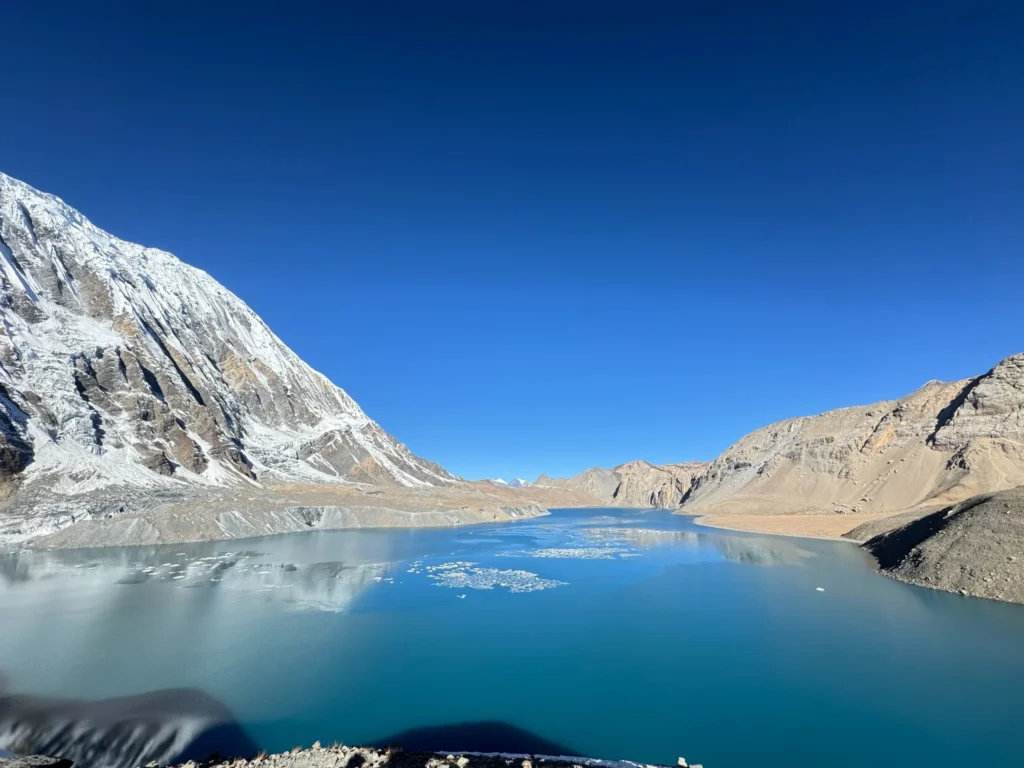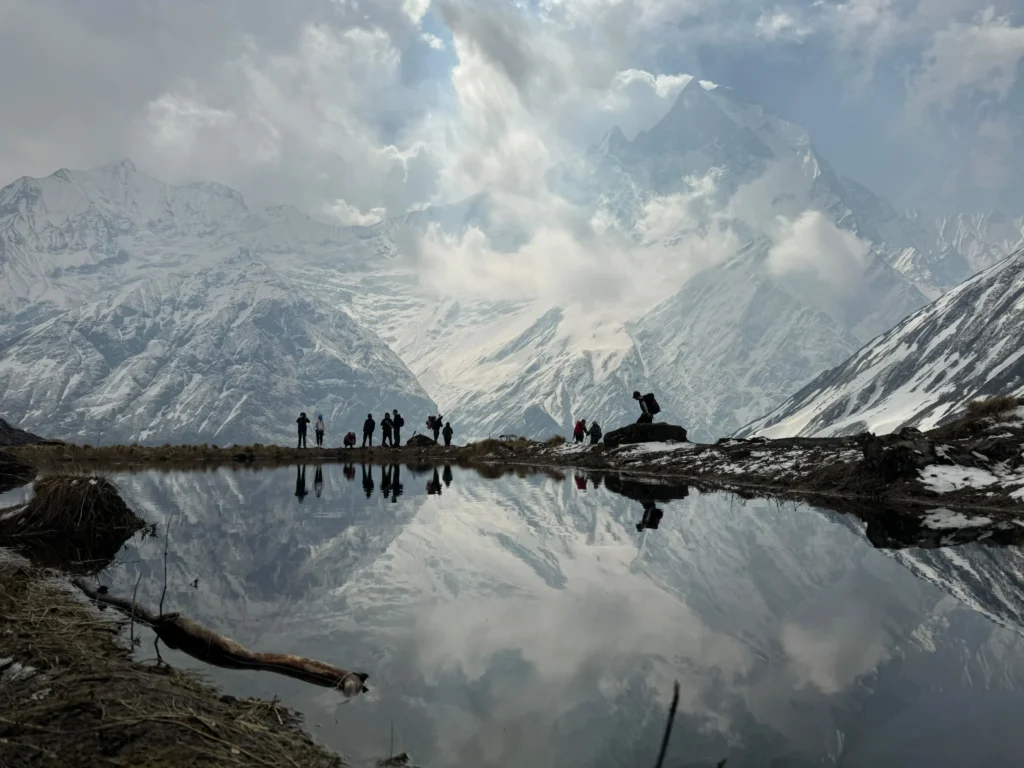Annapurna Circuit Trek with Tilicho Lake
- Annapurna Conservation Area, Nepal - Show on map
- 15 Days
Duration
15 Days
Max. Altitude
5416m
Difficulty Level
Hard
One Way Distance
160-230Km
Start/End Point
Kathmandu
Best Season
Autumn/Spring
Duration
15 Days
Max. Altitude
5416m
Difficulty Level
Hard
One Way Distance
160-230Km
Start/End Point
Kathmandu
Best Season
Autumn/Spring
Overview
The Annapurna Circuit with Tilicho Lake is one of the most adventurous treks in Nepal. It combines the beauty of the classic circuit with the thrill of visiting one of the highest lakes in the world. This journey takes you through changing landscapes, ancient villages, sacred temples, and high mountain passes.
The Annapurna Circuit Trek offers the perfect blend of natural beauty, cultural encounters, and adventure. Starting with a drive from Kathmandu to Chamje, the trail winds through mountain valleys, over suspension bridges, and past ancient monasteries. You’ll hike through the beautiful Manang Valley, visit the breathtaking Tilicho Lake, and challenge yourself by crossing the Thorong La Pass. The journey ends in the Kali Gandaki Valley with a visit to Muktinath before flying out from Jomsom to Pokhara and then Kathmandu.
Each day offers something new and exciting. Below is a detailed 15-day itinerary designed to help you understand the route and what to expect.
Highlights of Annapurna Circuit Trek
- Explore the diverse landscapes of the Annapurna region, from lush valleys to dry alpine terrain
- Visit Tilicho Lake, one of the highest lakes in the world, at 4,919m
- Cross Thorong La Pass at 5,416m, the highest point of the trek
- Experience the culture of Himalayan villages like Manang, Pisang, and Muktinath
- Enjoy scenic flights between Jomsom, Pokhara, and Kathmandu
- Witness panoramic views of Annapurna, Dhaulagiri, and other Himalayan giants
- Spend time in Pokhara, a relaxing lakeside city
Trek Itinerary & Route Map
Day 01Arrival in Kathmandu (1400m/4593ft)
Welcome to Nepal. Your journey begins in Kathmandu. Once you land at Tribhuvan International Airport, our team will greet you and transfer you to your hotel in the city. After check-in, you can explore the vibrant streets of Thamel, a lively area filled with shops, cafes, and trekking stores or relax before tomorrow’s journey begins.
Day 02Drive from Kathmandu to Chamje (1430m/4691ft) via Besisahar (760m/2493ft)
Today, you leave early for a long scenic drive. The first stretch to Besisahar is smooth and takes you through hills and terraced farmland. From Besisahar, the road becomes rough and exciting as you enter the Marsyangdi River Valley. By evening, you arrive in Chamje, where you rest for the night.
Day 03Drive from Chamje to Dhukur Pokhari (3240m/10,630ft) and Trek to Upper Pisang (3300m/10,826ft)
After breakfast, a short drive takes you to Dhukur Pokhari. From here, your real trek begins. You walk uphill along the pine forest trails. Soon, the views open up and you get your first glimpse of the Annapurna ranges. By late afternoon, you reach Upper Pisang.
Day 04Trek to Nagwal (3660m/12,008ft)
Today’s trek takes you along the scenic high route to Nagwal. You walk along stone paths and pass through quiet alpine forests. The trail climbs gently until you reach the village of Nagwal. You pass through Ghyaru village with its stone houses and prayer flags fluttering in the wind. The path offers uninterrupted views of snow-covered peaks, making it one of the most beautiful sections of the trek. The mountain views here are also beautiful. Also, this place is perfect for getting used to the altitude.
Day 05Trek from Nagawal to Manang (3540m/11,300ft)
The trail continues through dry landscapes and yak pastures. You visit Braga Monastery, a historic place full of cultural value. After a relaxed walk, you reach Manang, a bustling village with bakeries, shops, and panoramic views. This is one of the main stops on the trek. The village is lively and filled with trekkers preparing to cross the Thorong La Pass.
Day 06Acclimatization in Manang (3,540m/11,300ft)
You leave the main Annapurna Circuit trail and head toward Tilicho Base Camp. The trail is narrow and exciting, passing through Shree Kharka. It goes through landslide-prone areas and rocky terrain. You walk slowly and carefully. By evening, you reach the Tilicho Base Camp. It’s cold but peaceful, with high mountains surrounding the camp.
Day 07Trek to Tilicho Base Camp (4150m/13,615ft)
Welcome to Nepal. Your journey begins in Kathmandu. Once you land at Tribhuvan International Airport, our team will greet you and transfer you to your hotel in the city. After check-in, you can explore the vibrant streets of Thamel, a lively area filled with shops, cafes, and trekking stores or relax before tomorrow’s journey begins.
Day 08Hike to Tilicho Lake (4919m/16,138ft) and Return to Shree Kharka (4200m)
This is one of the most rewarding days of the Annapurna Circuit Trek. Start early for the hike to Tilicho Lake, one of the highest lakes in the world. The lake sits at nearly 5,000 meters and is surrounded by snow-covered peaks. The climb is slow and steady, but the sight of the turquoise lake beneath towering peaks makes it all worth it. After spending some time at the lake, you descend carefully and return to Shree Kharka for the night.
Day 09Trek from Tilicho Base Camp to Yak Kharka (4040m/13,254ft)
You return to the main Annapurna Circuit trail and continue your gradual ascent toward Yak Kharka. The trail climbs gradually through alpine meadows. You may see herds of yaks grazing along the way and dramatic views around every corner. The views remain stunning. You reach Yak Kharka in the afternoon and rest early.
Day 10Trek from Yak Kharka to Thorong Phedi (4450m/14,600ft)
Today is a shorter day to allow your body more time to adjust to the altitude. You move higher in altitude, so you walk at a slow and steady pace. Thorong Phedi is the last stop before the Thorong La pass. You arrive early to rest and prepare for the next day’s big challenge.
Day 11Cross Thorong La Pass (5416m/17,769ft) and Trek to Muktinath (3800m/12,467ft)
Begin your ascent before sunrise to cross the famous Thorong La Pass at 5,416m. This is the toughest and most exciting day of the trek. You begin early and climb to Thorong La Pass, which stands at 5,416 meters. The wind is strong and the air is thin, but the views are unforgettable. At the top, you are rewarded with views of the Annapurna and Dhaulagiri ranges. Descend to Muktinath, a sacred pilgrimage site.
Day 12Drive from Muktinath to Jomsom (2720m/8924ft)
After visiting the Muktinath temple, take a short and scenic drive to Jomsom. This town is located in the Kali Gandaki Valley. It’s a great place to rest and reflect on your journey. If time allows, explore Marpha village, known for its apple orchards and stone-paved lanes. Return to Jomsom and relax.
Day 13Fly from Jomsom to Pokhara (827m/2713ft)
Today, you take a morning flight to Pokhara. Enjoy a dramatic morning flight between mountains as you head to Pokhara. The flight is short but scenic. Once in Pokhara, you can enjoy the lakeside atmosphere, great food and a comfortable stay.
Day 14Fly from Pokhara to Kathmandu
After breakfast, you board a flight to Kathmandu. Once you arrive, you’ll be transferred to your hotel. You can spend the rest of the day shopping or enjoying your last day in Nepal.
Day 15Departure from Kathmandu
Your Annapurna Circuit Trek ends today. Our team will transfer you to the airport based on your flight schedule. You leave Nepal with lifelong memories of a journey filled with mountains, culture, holy lakes, and adventure.

Includes/Excludes for Annapurna Circuit Trek
- Airport pick-up and drop-off.
- Hotel stay in Kathmandu with breakfast.
- 1 night hotel stay in Pokhara with breakfast.
- All necessary trekking permits and a TIMS card.
- Transportation: Kathmandu–Chamje, Muktinath–Jomsom (by private or shared jeep).
- Domestic flights: Jomsom–Pokhara and Pokhara–Kathmandu.
- All meals during the trek (B/L/D).
- Accommodation in lodges/guest houses during the trek.
- English-speaking guide and porter (2 trekkers: 1 porter).
- Staff salary, insurance, and equipment.
- First aid kit and emergency oxygen.
- Farewell dinner in Kathmandu.
- International flights and Nepal visa fees.
- Meals in Kathmandu and Pokhara (except breakfast).
- Extra nights due to early return or bad weather.
- Personal expenses (wifi, laundry, hot showers, etc.).
- Travel and rescue insurance.
- Tips for the guide and the porter.
- Any services not mentioned in the inclusions.
Note
Please note that due to ongoing road construction along the Prithvi Highway, the drive from Kathmandu to Pokhara has become more time-consuming and dusty than usual. While this journey typically takes around 6–7 hours, current conditions may extend it to 8–9 hours due to traffic congestion and air pollution. We kindly ask for your patience and understanding during this transitional period.
Gears & Equipment
Item
Quantity
1 set of base/thermal Layer and 1 mid-layer
1
1 Set outer layer
1
1 waterproof jacket and 1 waterproof trousers, or raincoat/punchoo instead.
1
1 pair of lightweight trekking trousers or zip-off pants.
1
2 trekking t-shirts/shirts-merino is ideal
2
Four Season Sleeping bag.
1
Four Season Down Jacket.
1
1 pair liner gloves
1
1 warm wool hat
1
1 sunhat or similar
1
Sleeping bag liner
–
Travel towel
–
Sunscreen
–
Moisturizer
–
Lip Balm
–
Toilet Paper
–
1 rucksack/duffle bag for the porters to carry with your overnight kit
1
1-day pack (approx. 30ltr) with a waterproof cover
1
2 x 1ltr water bottles or CamelBak
2
1 x head torch
1
Water purification tablets
–
1 pair trekking boots (must be worn in)
1
Sandals or hut shoes
–
3 pairs thick walking socks / 3 pairs lighter walking socks
3
Running Shoes or sneakers.
1
Power bank
–
Thermal Flask
–
Adaptors: Nepal uses Type D, C and M
–
Accommodation and Food
Throughout the trek, accommodation will be provided in a mix of standard teahouses and lodges. These are cosy, clean, and run by local families. In major towns like Kathmandu and Pokhara, you’ll stay in comfortable hotels with modern amenities. During the trek, expect twin-sharing rooms with shared or attached bathrooms, depending on the location. Meals include a mix of local Nepali dishes and international options.
Food Provided: Breakfast, lunch, and dinner during the trek; breakfast in cities. Meals are served fresh, and you can choose from available options at each lodge.
FAQs
1. How difficult is the Annapurna Circuit Trek?
The Annapurna Circuit Trek is considered moderately to highly challenging. It involves several days of walking, steep climbs, and high altitudes. With good preparation and acclimatization, most trekkers with average fitness can complete it.
2. What is the best time to do the Annapurna Circuit Trek?
Spring (March to May) and autumn (September to November) are the best seasons. These months offer clear skies, pleasant weather, and incredible mountain views. Monsoon and winter are generally avoided due to rain, snow, and trail conditions.
3. Is altitude sickness common on the Annapurna Circuit Trek?
Yes, altitude sickness is a real risk, especially when crossing Thorong La Pass. The trek includes built-in acclimatization days, and it’s important to ascend gradually, drink lots of fluids, and listen to your body.
4. Do I need a guide or porter for the Annapurna Circuit Trek?
As of 2025, hiring a licensed guide for the Annapurna Circuit Trek is mandatory for trekkers to comply with Nepal’s trekking regulations and ensure safety. While porters are not required, they are highly recommended to carry your gear and make the trek more comfortable and enjoyable.
5. What kind of accommodation is available on the Annapurna Circuit Trek?
You’ll stay in teahouses or simple guesthouses run by locals. They provide clean rooms, warm meals, and a place to rest. Most rooms are twin-sharing with shared bathrooms, though private options are available in some villages.
6. What type of food is served during the Annapurna Circuit Trek?
Food options during the trek include traditional Nepali meals like dal bhat, as well as pasta, fried rice, soups, eggs, and pancakes. Meals are made fresh at the lodges and help keep your energy up during the trek.
7. Can I charge my phone and use Wi-Fi on the Annapurna Circuit Trek?
Yes, but the availability of it varies by village. Charging is usually available for a small fee, and Wi-Fi can be found in some lodges. Bring a power bank and expect limited connectivity in higher areas.
8. How should I prepare for the Annapurna Circuit Trek?
You should build your fitness with regular walking, hiking, or cardio workouts a few weeks before the trek. Focus on leg strength, stamina, and getting used to walking with a backpack.
9. What should I do in case of an emergency during the Annapurna Circuit Trek?
In case of an emergency, your guide will assess the situation and take necessary steps, whether it’s administering first aid or arranging a helicopter evacuation. Trekking agencies usually stay in contact with guides via phone or radio. It’s important to have travel insurance that covers high-altitude trekking and emergency evacuation in Nepal.
Need help with your trek?
Reach out to our travel experts
Starts at
USD $1300 $900 / Minimum 2 Pax
Plan Your Hike

Nepal🇳🇵
What Trekkers are Saying About Us
Upper Mustang was unlike anywhere else I’ve been. The landscape is surreal. Suman Limbu’s deep knowledge of the area and stories about local culture made the trek unforgettable. I really felt connected to the place.

Megan Walker
Traveler from USA
Trekking the Annapurna Circuit was unforgettable. The landscape changes kept me in awe every day. Our guide, Aryan Lama, was fantastic; always patient and encouraging, especially on the steep parts. His knowledge about the region made the trek richer.

Claire Adams
Traveler from Australia
Langtang was peaceful with breathtaking glacier views. Aryan Lama’s easy-going nature made the trek enjoyable even on the harder days. It felt less like a guided tour and more like trekking with a knowledgeable friend.

Daryl Wong
Traveler from Singapore
Tilicho Lake’s turquoise water and surrounding peaks were absolutely stunning. John Bipra’s encouragement helped me push through the toughest parts. The whole trek was perfectly planned, which made the experience unforgettable.

Mateus Costa
Traveler from Brazil
Everest Base Camp is a dream for any trekker. The trek was tough, but our guide John Bipra made it manageable with his calm and experienced leadership. I never felt alone or overwhelmed, and that made all the difference.

Élodie Martin
Traveler from France
Dhap Dam’s calm waters and green surroundings made for an amazing day hike. I really appreciated how BeThere handled all the details. It felt like they had thought of everything so the day went perfectly.

Sophie Chen
Traveler from Canada
Need help choosing a trail?
Connect with a local and plan your perfect trek.


